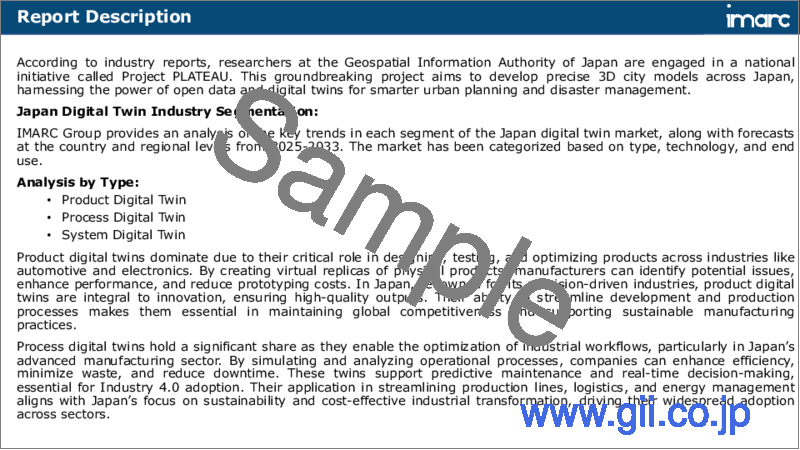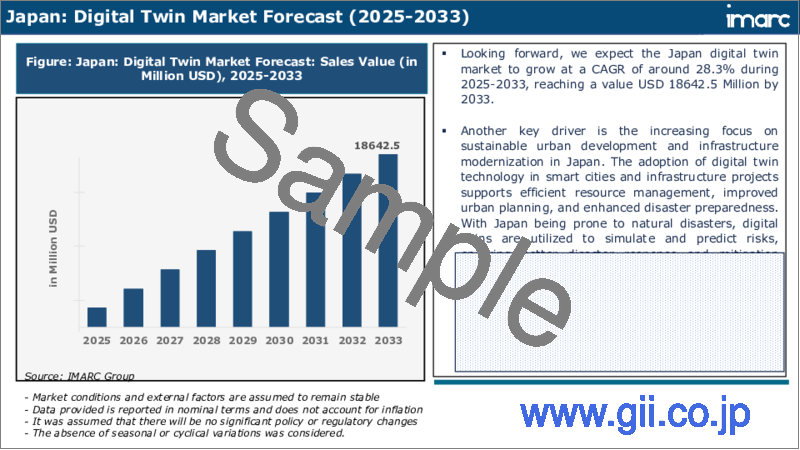|
|
市場調査レポート
商品コード
1609931
日本のデジタルツインの市場規模、シェア、動向、予測:タイプ、技術、最終用途、地域別、2025年~2033年Japan Digital Twin Market Size, Share, Trends and Forecast by Type, Technology, End Use, and Region, 2025-2033 |
||||||
カスタマイズ可能
|
|||||||
| 日本のデジタルツインの市場規模、シェア、動向、予測:タイプ、技術、最終用途、地域別、2025年~2033年 |
|
出版日: 2024年12月05日
発行: IMARC
ページ情報: 英文 119 Pages
納期: 5~7営業日
|
全表示
- 概要
- 目次
日本のデジタルツイン市場の市場規模は2024年に15億4,620万米ドルに達しました。IMARC Groupは、2025年から2033年にかけての成長率(CAGR)は28.3%で、2033年には186億4,250万米ドルに達すると予測しています。製造業へのデジタル技術の統合、デジタルツインをサポートする技術の継続的な発展、スマートシティ構想やインフラ開拓への重点の高まりなどが、市場を牽引する主な要因となっています。
本レポートで扱う主な質問
- 日本のデジタルツイン市場はこれまでどのように推移し、今後どのように推移するのか?
- 日本のデジタルツイン市場にCOVID-19が与えた影響は?
- 日本のデジタルツイン市場のタイプ別内訳は?
- 日本のデジタルツイン市場の技術別の内訳は?
- 日本のデジタルツイン市場の最終用途別の内訳は?
- 日本のデジタルツイン市場のバリューチェーンにはどのような段階がありますか?
- 日本のデジタルツインにおける主な促進要因と課題は何か?
- 日本のデジタルツイン市場の構造と主要プレーヤーは?
- 日本のデジタルツイン市場における競合の程度は?
目次
第1章 序文
第2章 調査範囲と調査手法
- 調査の目的
- ステークホルダー
- データソース
- 市場推定
- 調査手法
第3章 エグゼクティブサマリー
第4章 日本のデジタルツイン市場:イントロダクション
- 概要
- 市場力学
- 業界動向
- 競合情報
第5章 日本のデジタルツイン市場情勢
- 過去および現在の市場動向(2019年~2024年)
- 市場予測(2025-2033)
第6章 日本のデジタルツイン市場:タイプ別の内訳
- 製品デジタルツイン
- プロセスデジタルツイン
- システムデジタルツイン
第7章 日本のデジタルツイン市場:技術別の内訳
- IoTとIIoT
- ブロックチェーン
- 人工知能と機械学習
- 拡張現実、仮想現実、複合現実
- ビッグデータ分析
- 5G
第8章 日本のデジタルツイン市場:最終用途別の内訳
- 航空宇宙・防衛
- 自動車・輸送
- ヘルスケア
- エネルギー・ユーティリティ
- 石油・ガス
- 農業
- 住宅および商業
- 小売・消費財
- 通信
- その他
第9章 日本のデジタルツイン市場:競合情勢
- 概要
- 市場構造
- 市場プレーヤーのポジショニング
- 主要成功戦略
- 競合ダッシュボード
- 企業評価象限
第10章 主要企業のプロファイル
第11章 日本のデジタルツイン市場:業界分析
- 促進要因・抑制要因・機会
- ポーターのファイブフォース分析
- バリューチェーン分析
第12章 付録
Japan digital twin market size reached USD 1,546.2 Million in 2024. Looking forward, IMARC Group expects the market to reach USD 18,642.5 Million by 2033, exhibiting a growth rate (CAGR) of 28.3% during 2025-2033. The integration of digital technologies into manufacturing, continuous advancements in technologies supporting digital twins, and the growing emphasis on smart city initiatives and infrastructure development represent some of the key factors driving the market.
A digital twin is a virtual representation of a physical object, system, or process. It utilizes real-time data and simulations to mirror the behavior and characteristics of its physical counterpart. It constantly updates with live data from sensors and other sources, ensuring accurate representation. It enables modeling and simulation of scenarios, aiding in predictive analysis and problem-solving. It is compatible with the Internet of Things (IoT) devices and other digital systems, enhancing their ability to reflect real-world conditions. It facilitates early detection of issues through real-time monitoring, reducing downtime and maintenance costs. It identifies inefficiencies and potential problems, allowing for cost-effective solutions. It helps manage urban infrastructure, ranging from transportation systems to energy grids. It is widely used for personalized medicine, treatment simulations, and monitoring patient health in real-time. Besides this, it is also utilized in the aerospace sector for designing and testing aircraft components, monitoring equipment health, and predicting maintenance needs.
Japan Digital Twin Market Trends:
The advent of Industry 4.0 and the integration of digital technologies into manufacturing represent one of the key factors favoring the market growth. Additionally, the growing emphasis of Japan on smart city initiatives and infrastructure development is promoting the adoption of digital twins as they offer comprehensive solutions for managing complex urban environments. Apart from this, the rising focus of the country on advanced manufacturing techniques, such as smart factories, is driving the demand for sophisticated solutions like digital twins. These virtual replicas enable real-time monitoring, predictive maintenance, and agile responses to changing production needs. Furthermore, the widespread adoption of the Internet of Things (IoT) devices in Japan is contributing to the growth of the market. These virtual models leverage the continuous data streams from IoT sensors to provide accurate and dynamic representations of physical assets. Moreover, governing authorities of Japan are introducing policies and initiatives to foster digital transformation and innovation, which is creating a conducive environment for the adoption of digital twins across various sectors in Japan. Along with this, continuous advancements in technologies supporting digital twins, such as artificial intelligence (AI) and machine learning, are driving their adoption. These innovations enhance the capabilities of digital twins in terms of analytics, decision-making, and automation. In addition, the increasing collaborations among different industries and sectors, facilitated by digital twin technologies, are leading to shared insights and innovations. This cross-industry synergy accelerates the overall growth and adoption of digital twins in Japan. Moreover, the rising frequency of natural disasters in Japan is driving the need for resilient infrastructure and disaster preparedness. Digital twins contribute by providing real-time monitoring of critical assets, enabling quick response to emergencies, and facilitating efficient recovery efforts.
Japan Digital Twin Market Segmentation:
Type Insights:
- Product Digital Twin
- Process Digital Twin
- System Digital Twin
Technology Insights:
- IoT and IIoT
- Blockchain
- Artificial Intelligence and Machine Learning
- Augmented Reality, Virtual Reality and Mixed Reality
- Big Data Analytics
- 5G
End Use Insights:
- Aerospace and Defense
- Automotive and Transportation
- Healthcare
- Energy and Utilities
- Oil and Gas
- Agriculture
- Residential and Commercial
- Retail and Consumer Goods
- Telecommunication
- Others
Competitive Landscape:
The market research report has also provided a comprehensive analysis of the competitive landscape. Competitive analysis such as market structure, key player positioning, top winning strategies, competitive dashboard, and company evaluation quadrant has been covered in the report. Also, detailed profiles of all major companies have been provided.
Key Questions Answered in This Report:
- How has the Japan digital twin market performed so far and how will it perform in the coming years?
- What has been the impact of COVID-19 on the Japan digital twin market?
- What is the breakup of the Japan digital twin market on the basis of type?
- What is the breakup of the Japan digital twin market on the basis of technology?
- What is the breakup of the Japan digital twin market on the basis of end use?
- What are the various stages in the value chain of the Japan digital twin market?
- What are the key driving factors and challenges in the Japan digital twin?
- What is the structure of the Japan digital twin market and who are the key players?
- What is the degree of competition in the Japan digital twin market?
Table of Contents
1 Preface
2 Scope and Methodology
- 2.1 Objectives of the Study
- 2.2 Stakeholders
- 2.3 Data Sources
- 2.3.1 Primary Sources
- 2.3.2 Secondary Sources
- 2.4 Market Estimation
- 2.4.1 Bottom-Up Approach
- 2.4.2 Top-Down Approach
- 2.5 Forecasting Methodology
3 Executive Summary
4 Japan Digital Twin Market - Introduction
- 4.1 Overview
- 4.2 Market Dynamics
- 4.3 Industry Trends
- 4.4 Competitive Intelligence
5 Japan Digital Twin Market Landscape
- 5.1 Historical and Current Market Trends (2019-2024)
- 5.2 Market Forecast (2025-2033)
6 Japan Digital Twin Market - Breakup by Type
- 6.1 Product Digital Twin
- 6.1.1 Overview
- 6.1.2 Historical and Current Market Trends (2019-2024)
- 6.1.3 Market Forecast (2025-2033)
- 6.2 Process Digital Twin
- 6.2.1 Overview
- 6.2.2 Historical and Current Market Trends (2019-2024)
- 6.2.3 Market Forecast (2025-2033)
- 6.3 System Digital Twin
- 6.3.1 Overview
- 6.3.2 Historical and Current Market Trends (2019-2024)
- 6.3.3 Market Forecast (2025-2033)
7 Japan Digital Twin Market - Breakup by Technology
- 7.1 IoT and IIoT
- 7.1.1 Overview
- 7.1.2 Historical and Current Market Trends (2019-2024)
- 7.1.3 Market Forecast (2025-2033)
- 7.2 Blockchain
- 7.2.1 Overview
- 7.2.2 Historical and Current Market Trends (2019-2024)
- 7.2.3 Market Forecast (2025-2033)
- 7.3 Artificial Intelligence and Machine Learning
- 7.3.1 Overview
- 7.3.2 Historical and Current Market Trends (2019-2024)
- 7.3.3 Market Forecast (2025-2033)
- 7.4 Augmented Reality, Virtual Reality and Mixed Reality
- 7.4.1 Overview
- 7.4.2 Historical and Current Market Trends (2019-2024)
- 7.4.3 Market Forecast (2025-2033)
- 7.5 Big Data Analytics
- 7.5.1 Overview
- 7.5.2 Historical and Current Market Trends (2019-2024)
- 7.5.3 Market Forecast (2025-2033)
- 7.6 5G
- 7.6.1 Overview
- 7.6.2 Historical and Current Market Trends (2019-2024)
- 7.6.3 Market Forecast (2025-2033)
8 Japan Digital Twin Market - Breakup by End Use
- 8.1 Aerospace and Defense
- 8.1.1 Overview
- 8.1.2 Historical and Current Market Trends (2019-2024)
- 8.1.3 Market Forecast (2025-2033)
- 8.2 Automotive and Transportation
- 8.2.1 Overview
- 8.2.2 Historical and Current Market Trends (2019-2024)
- 8.2.3 Market Forecast (2025-2033)
- 8.3 Healthcare
- 8.3.1 Overview
- 8.3.2 Historical and Current Market Trends (2019-2024)
- 8.3.3 Market Forecast (2025-2033)
- 8.4 Energy and Utilities
- 8.4.1 Overview
- 8.4.2 Historical and Current Market Trends (2019-2024)
- 8.4.3 Market Forecast (2025-2033)
- 8.5 Oil and Gas
- 8.5.1 Overview
- 8.5.2 Historical and Current Market Trends (2019-2024)
- 8.5.3 Market Forecast (2025-2033)
- 8.6 Agriculture
- 8.6.1 Overview
- 8.6.2 Historical and Current Market Trends (2019-2024)
- 8.6.3 Market Forecast (2025-2033)
- 8.7 Residential and Commercial
- 8.7.1 Overview
- 8.7.2 Historical and Current Market Trends (2019-2024)
- 8.7.3 Market Forecast (2025-2033)
- 8.8 Retail and Consumer Goods
- 8.8.1 Overview
- 8.8.2 Historical and Current Market Trends (2019-2024)
- 8.8.3 Market Forecast (2025-2033)
- 8.9 Telecommunication
- 8.9.1 Overview
- 8.9.2 Historical and Current Market Trends (2019-2024)
- 8.9.3 Market Forecast (2025-2033)
- 8.10 Others
- 8.10.1 Historical and Current Market Trends (2019-2024)
- 8.10.2 Market Forecast (2025-2033)
9 Japan Digital Twin Market - Competitive Landscape
- 9.1 Overview
- 9.2 Market Structure
- 9.3 Market Player Positioning
- 9.4 Top Winning Strategies
- 9.5 Competitive Dashboard
- 9.6 Company Evaluation Quadrant
10 Profiles of Key Players
- 10.1 Company A
- 10.1.1 Business Overview
- 10.1.2 Product Portfolio
- 10.1.3 Business Strategies
- 10.1.4 SWOT Analysis
- 10.1.5 Major News and Events
- 10.2 Company B
- 10.2.1 Business Overview
- 10.2.2 Product Portfolio
- 10.2.3 Business Strategies
- 10.2.4 SWOT Analysis
- 10.2.5 Major News and Events
- 10.3 Company C
- 10.3.1 Business Overview
- 10.3.2 Product Portfolio
- 10.3.3 Business Strategies
- 10.3.4 SWOT Analysis
- 10.3.5 Major News and Events
- 10.4 Company D
- 10.4.1 Business Overview
- 10.4.2 Product Portfolio
- 10.4.3 Business Strategies
- 10.4.4 SWOT Analysis
- 10.4.5 Major News and Events
- 10.5 Company E
- 10.5.1 Business Overview
- 10.5.2 Product Portfolio
- 10.5.3 Business Strategies
- 10.5.4 SWOT Analysis
- 10.5.5 Major News and Events
11 Japan Digital Twin Market - Industry Analysis
- 11.1 Drivers, Restraints, and Opportunities
- 11.1.1 Overview
- 11.1.2 Drivers
- 11.1.3 Restraints
- 11.1.4 Opportunities
- 11.2 Porters Five Forces Analysis
- 11.2.1 Overview
- 11.2.2 Bargaining Power of Buyers
- 11.2.3 Bargaining Power of Suppliers
- 11.2.4 Degree of Competition
- 11.2.5 Threat of New Entrants
- 11.2.6 Threat of Substitutes
- 11.3 Value Chain Analysis





